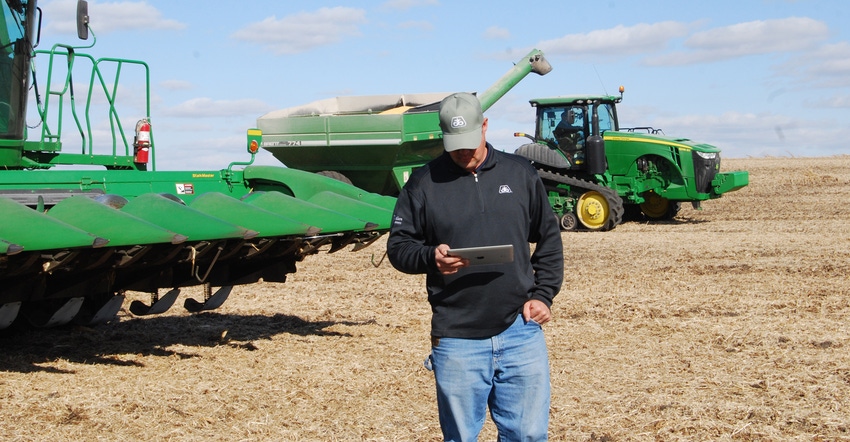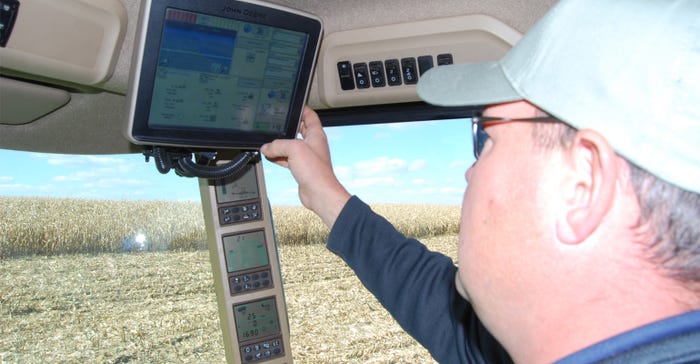October 2, 2020

When heading into the field for harvest, make sure your monitors, sensors and scales are getting accurate numbers. Taking the time to calibrate your combine yield monitor is the first step in making sure you are using high-quality yield data to make decisions in your farming operation.
Iowa State University’s Digital Ag team provides an online interactive monitor guide with step-by-step instructions for operating your displays. Refer to this tool for directions on how to calibrate your combine’s yield monitor. Ryan Bergman, program coordinator in ag technology for the ISU team, provides the following suggestions and information. ISU’s Matt Darr and Levi Powell also contributed to this article.
Use single or multipoint calibration? Most yield monitoring systems require a single or multipoint calibration. It’s important to know what type of calibration process your particular yield monitor requires. Refer to the manufacturer’s guidelines to be sure you are meeting or exceeding those requirements. Some manufacturers now offer yield monitors with self-calibrating systems that require little to no input from the operator.
For multipoint calibrations during harvest, these loads should be between 3,000 and 6,000 pounds. For single-point calibrations, these loads can be larger — up to a full grain tank. A typical calibration process requires three steps:
Weigh the calibration load on a grain cart or truck to get a ground-truth weight for the load.
Enter the ground-truth weight into the yield monitor display.
This process is repeated for multipoint calibrations using different crop flow rates.
Is your scale accurate? No matter the make and model of your yield monitor, a scale system is needed to get a “ground truth” load weight. There are many ways to accomplish this, including using seed buggies with scales, grain carts with scales or truckload scale tickets from an elevator. When collecting ground-truth load weights for your yield monitor calibration, it is important to verify that the scale system you are using is accurate, or you could be introducing more error into your yield data.
Most growers verify their grain cart scales against truck load net weights from elevator scale tickets. This is a good practice and an easy way to ensure your grain cart scales are still accurate throughout the season. However, when using your grain cart to calibrate your yield monitor, consider leaving the grain cart half full when collecting ground-truth weights. This will ensure the weight range on the grain cart scales is closer to the full cart weight values that you have been verifying against elevator tickets.
Why a multipoint calibration process? Yield monitors calculate yield based on fluctuations in mass flow rate. The yield of any given crop will naturally fluctuate throughout a field due to a host of agronomic factors. This means that even if you drive at a constant speed with the combine, the actual flow rate or throughput of the combine will fluctuate as the yield changes. It’s important to have calibration points for these different flow rate ranges to ensure the yield monitor is accurately calculating yield.
These changes in flow rate can be manually simulated for calibration purposes by driving at different ground speeds through an area of the field with consistent yield. It’s important to drive a consistent ground speed for the entire calibration load. Collect several calibration loads at your normal operating speed (for example, 4 mph). Then capture calibration loads at slower and faster ground speeds (2, 3 and 5 mph). This process will manually fluctuate the flow rate through the combine and ensure that you have multiple points throughout the calibration curve.
Failing to calibrate at multiple flow rates will result in less accurate field totals and spatial distribution of yield on a yield map.
Should one recalibrate when crop moisture changes? Recalibrate your yield monitor throughout the harvest season when crop conditions change. Changes in grain moisture can affect the accuracy of the calibration, and as your crop continues to dry down later in the season, the yield monitor’s sensor will react differently. Yield monitors in corn are particularly sensitive to moisture changes. Corn that is harvested above 20% moisture will require recalibration for every 2.5% change in moisture to maintain yield monitor error of less than 5%.
 MEASURING MOISTURE: Corn moisture can influence a yield monitor’s accuracy.
MEASURING MOISTURE: Corn moisture can influence a yield monitor’s accuracy.

As you go through the season, pay close attention to the mechanical components of the grain handling and yield monitor system. Inspect the sensor periodically for dirt buildup or other debris. Regularly check for proper tension on the combine’s clean grain elevator chain, as this is critical in maintaining consistent yield monitor accuracy. If you have retention in the clean grain elevator chain, this will often require a new yield monitor calibration to be completed.
Source: ISU, which is solely responsible for the information provided and is wholly owned by the source. Informa Business Media and all its subsidiaries are not responsible for any of the content contained in this information asset.
Read more about:
YieldsYou May Also Like




